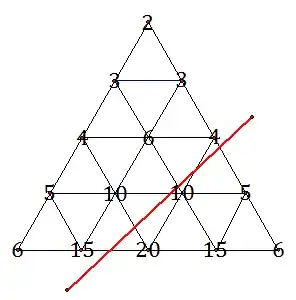Consider Pascal's triangle with $n$ rows, without the $1$s, with each number corresponding to a vertex on a pyramid of equilateral triangles, as shown below with example $n=5$.
Can the triangle be divided by a straight line (that does not pass through any vertex) into two regions of equal sums?
(That is, does there exist an $n$ such that Pascal's triangle with $n$ rows, without the $1$s, can be divided by a straight line into two regions of equal sums?)
For example, with $n=5$, the red line below fails to divide the triangle into two regions of equal sums: the upper-left region has a sum of $58$, and the bottom-right region has a sum of $56$.
I have tried to do this with different size triangles, without success. It seems that it cannot be done, but I don't know how to prove it.
Remarks
We exclude the $1$s because the triangle with the $1$s has a total sum of $2^n-1$, an odd number, making an equal split obviously impossible.
The sums of the all the terms in the first $n$ rows (not just one row) are given by A145654 (ignoring the initial $0$): $2,8,22,52,114,240,494\dots$
I considered the partial sums of a row of Pascal's triangle, but such expressions are not easy.
I also tried to start with Pascal's triangle without the $1$s and without the terms $\binom{n}{1}$ and $\binom{n}{n-1}$, and I still couldn't split it. However, it is easy to split a triangle with terms $1*1\ 1*1\ 2\ 1*1\ 2\ 2\ 1*1\ 2\ 3\ 2\ 1$ (rows are separated by "$*$"; in each row, numbers increase by $1$ up to a max, then decrease by $1$.).
I'm more interested in the method used to answer this question, than the answer itself. I've been trying to demystify Pascal's triangle, but it still mystifies me.
EDIT:
Taking @Jean Marie's suggestion, I've added a left-justified version of the triangle, which is easier to use.
EDIT2:


